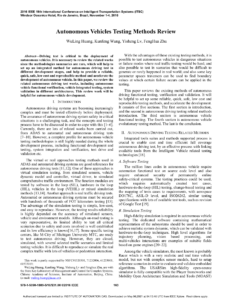Types of Autonomous Vehicles Testing Methods
Autonomous Vehicles Testing
Various methods of autonomous vehicles testing are being explored for the safety and reliability of these new cars. While all AV testing methods have their advantages and drawbacks, the same principles apply for any AV technology. In the case of self-driving systems, rigorous testing is the key to developing a fully functioning car. In fact, it is critical to train the autonomous system to handle a variety of situations. Below are some of the key autonomous vehicle testing methods being explored.
The operational design domain describes the physical and social environments where Autonomous vehicles testing will be tested. These environments include geographic regions, roadway types, speed ranges, environmental conditions, and other domain constraints. During testing, the passenger does not engage with the autonomous technology, monitor the vehicle, or make any decisions. Public riders may also ride in the autonomous vehicle without being compensated. However, it is important to note that testing methods must be designed for each of these scenarios.
To create a realistic simulation of the vehicle’s environment, developers can use real video sequences from test drives as the background. In addition to real data, they can also include virtual objects to improve the simulation. Advanced driver assistance systems are already on the market and will continue to grow as the technology advances. These technologies will be critical to safe driving, as all European and American cars must be equipped with forward-collision warning systems by 2020.

Types of Autonomous Vehicles Testing Methods
To test ADAS software, a variety of simulation methods have been developed over the past several years. For example, software-in-the-loop (SIL) simulation involves putting software into a virtual vehicle and driving it as if it were in a real vehicle. This allows developers to evaluate the code in a realistic setting. Another type of autonomous vehicles testing method is known as VEHIL, which involves a combination of artificial and real hardware.
While the development of self-driving systems is rapidly advancing, it is vital to validate their quality before deploying them. Testing is necessary to ensure the safety and reliability of these advanced driver assistance systems, which are the key to successful deployment. Whether the test involves a test or a field trial, autonomous vehicles need to be tested in different environments to determine how well they work. These tests can also prove to be a valuable resource for testing the safety of these new vehicles.
Another test method for AVs is disengagement. This method involves taking over a vehicle from human operators when it is in a dangerous situation. AVs have a high risk of accidents, especially those caused by other road users. AVs are highly susceptible to accidents when they share the road with pedestrians or bicyclists. Moreover, some of them have dangerous personalities that could potentially make them crash into other vehicles.

Autonomous Vehicles Testing Methods
Testing methods for autonomous vehicles vary by manufacturer. Different manufacturers have different understanding of the frequency of disengagement events, and some may not report their data adequately. Disengagement rates vary widely across manufacturers, ranging from two x 10-4 to three x 10-4 per mile. The difference between the frequencies might be a result of the level of maturity of the autonomous technology. Furthermore, the testing methods used to develop this technology have yet to be widely adopted.
Another common method of autonomous vehicle testing is called trajectory planning. A path planning algorithm is used to develop a plan for a mobile agent, and builds on research in mobile robots over the last decade. The problem is categorized into local and global planning, with the former being incrementally constructed based on the agent’s surroundings. Various planning algorithms are used to solve the path planning problem. The most important one is the lateral trajectory planning algorithm.
In order to make AVs as safe as possible, the various components of the system need to work properly. For example, the LiDAR sensor may detect a false signal if the distance is too close or too far. Automotive software can be modified to recognize such false signals. Likewise, cameras are also susceptible to being deceived. Cameras are used to detect traffic signs and objects in the road, and they are often used in automated vehicles.